Trying to introduce Gary Indiana in any sort of a traditional way is impossible, and writers who attempt that feat do so at their own peril. His career has spanned genres and mediums, and the only common thread running through it has been his reputation for being far more concerned with the integrity of his work than making a buck or a friend. As a result, when one looks back over the landscape of his life they will find great and uncompromising novels, photographs, and films—but also enough charred bridges to connect New York with Portugal. That dedication to craft over the bottom line is at least part of the reason why Gristle Springs, Gary’s new art show, is his first in over a decade.The show opened last weekend at Participant Inc., a gallery on Houston Street run by one of Gary's close friends. The first thing you notice upon entering is a gigantic photograph of a man taking a shower printed on organza silk hanging from the ceiling. Lining the walls are four-paneled photographs, similar to the ones he often uses in his VICE columns. The photographs, which were shot over the last three decades, don’t necessarily have anything to do with one another, but are meant to resemble footage from surveillance cameras found in stores and, increasingly, on the streets of major cities. In a back room three films, Soap, Plutot la Vie, and Unfinished Story, play on loop. Much like the photographs, the videos were filmed over a number of years and don’t relate to each other in any discernable way. I wanted to know more about the work, so I met up with Gary to chat about the show.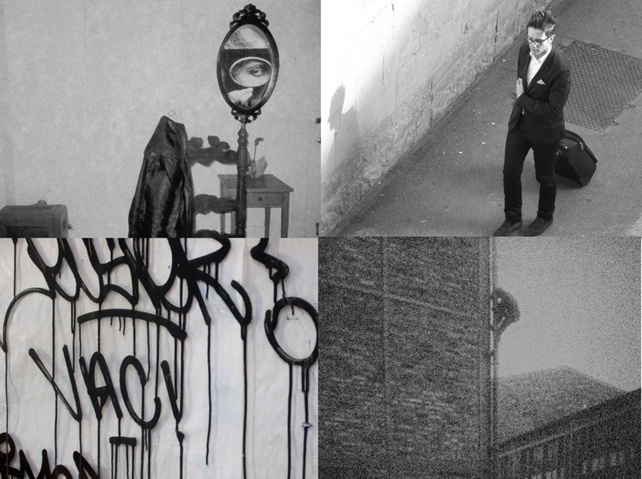 VICE: This is your first show in over ten years. Why the long break?
VICE: This is your first show in over ten years. Why the long break?
Gary Indiana: The last show I did was at American Fine Arts with Colin de Land, who was a very loved figure, a really smart guy. Then he died, and after Colin died other gallery people approached me, but they would all say things like, “Well, what do you want to do with this work?” and I would say, “I already did it. Do you mean, do I want to achieve world domination? Not particularly.” I mean, basically they were asking for a marketing strategy without coming right out and asking for a marketing strategy. That’s fine, but I wasn’t interested in doing that, because one advantage of not being particularly money-grubbing is that you don’t have to funnel all your energy in one direction. I’m not trying to make myself out as a noble person. I’m just bad at money. I’m bad at telling people why they should buy something I did. Of course, they’re welcome to. Please. But I was never a good hustler that way.So what’s different about this show? Why did you decided to do it after ten years?
Well, I’ve been working with pictures constantly since the last show. My friends and I had talked about me doing another show for a long time, and it just took several years for it to get to the point where I knew what I wanted to do. Also, I felt that if I was going to break out of this mold—if you’re a writer, particularly in America, that’s all you’re supposed to do—and actually establish in people’s heads that I do this seriously, I should probably do it now. I’m not going to be alive that much longer.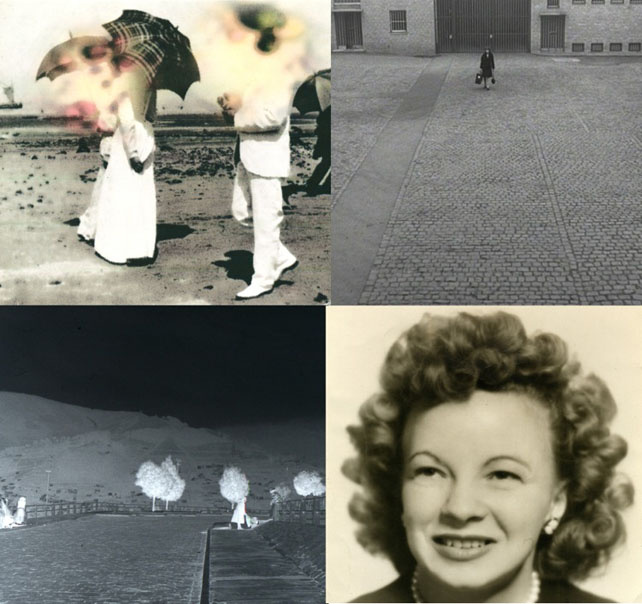 So do you think that the idea of people being able to do cross-discipline work is something we don’t have in America?
So do you think that the idea of people being able to do cross-discipline work is something we don’t have in America?
Anybody in Europe can do 40 different things, but here you’re supposed to be a specialist in one thing.I find that American writers more than American artists are really provincial people. They don’t mind being just writers because they live in this very clammy, creepy little world—writers’ conferences and PEN and all that stuff. It is really like going to a funeral to go to any of those events with poets and writers. Every time I go I feel like, Where’s the vodka, where’s the booze? Because this is a funeral.I don’t think you’re alone in that opinion. The photos in the show date back 30 years, right?
Strictly speaking, there are photos in the show that date that far back. Primarily the photos in the show were done in the last two or three years, but I’ve worked with a huge range of cameras since I started taking pictures in the 70s, and different series have been taken here, there, and all over the world, and there were certain things that I loved in all of them. But you can’t show them in a straightforward style—in a series with other photos shot at the same time or place—because they would just fight with each other. So I thought, How can I put these together in a way that will kind of turn the diversity of them into an asset? So that’s when I started making the cruciform things and diptychs and panels of images. The ones that are basically four panels, the images are not supposed to have anything directly to do with each other. I might have a private way of connecting them, but I don’t really tell myself a story. Part of the exercise was trying to arrange these pictures so that people would like seeing them together without necessarily figuring out why they were together.And you think their differences make the individual images stronger?
I do. I think a lot of them could conceivably stand on their own, but I don’t want them to. I think that they do sort of reinforce each other in a very peculiar way. It’s weird, because everything in the show is about not doing anything obvious or eliminating all the reasons to do it this way, except for what can’t be explained. Obviously some pieces have a different idea, like the Rosa Luxemburg piece and the Chinese cemetery piece, for example. I was trying to get at other things in those pictures. When I look at the show, I see where those pictures were taken and what I was thinking about when I took them, but I didn’t want to identify them necessarily in that way.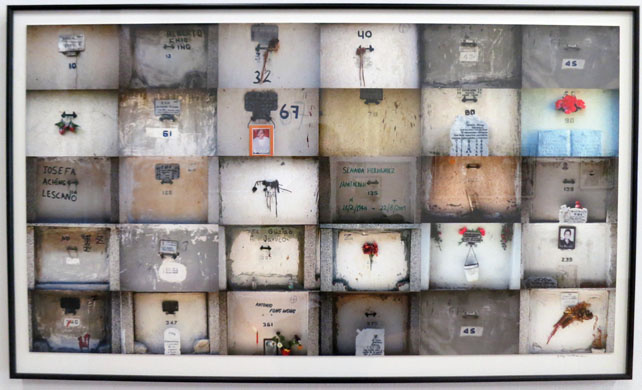 Speaking of the Chinese cemetery piece, I noticed that all of the graves have numbers on them and are arranged in order except for grave 45, which is repeated. Is there a reason behind that, or am I reading into it too much?
Speaking of the Chinese cemetery piece, I noticed that all of the graves have numbers on them and are arranged in order except for grave 45, which is repeated. Is there a reason behind that, or am I reading into it too much?
Well there is a reason, but it’s sort of contrary to what you would think. Those pictures were taken at a Chinese cemetery in Havana. Some are done in a way that you can tell the family has money, and some just have a name scrawled across them in pencil. And they do have numbers. I’m not actually sure what those numbers are supposed to correspond to, though. They’re not in order on the wall, but I figure they put them in some sort of weird Fibonacci order. Anyway, I repeated 45 because I didn’t want people to think that there was a system involved in that.So it was just to confuse people who thought they had it figured out?
Well I don’t want people to be like, “Oh, this is why this is the way it is.” So I just repeated that number, so people can see that this is a construction. The number doesn’t have any meaning to me, and the picture doesn’t have any more meaning than the rest of them. The four-panel images, which are reminiscent of surveillance screens, are not only a comment on our increasing lack of privacy, but on how we receive information now. It’s coming at us from all angles at all hours of the day. Do you think that makes people crazy? Is it harder to focus on one thing?
The four-panel images, which are reminiscent of surveillance screens, are not only a comment on our increasing lack of privacy, but on how we receive information now. It’s coming at us from all angles at all hours of the day. Do you think that makes people crazy? Is it harder to focus on one thing?
Yes and no. I think maybe people are evolving skills to cope with technology that people in the past didn’t have. I regularly go from here, which is the media capital of the country, to LA, to a place [Cuba] where I have no internet and no television. It’s really pulling the plug out, in a way you couldn’t even do in a place like Iceland or Dhakar, because all those places have WiFi. It’s possible to live over there for a long time without any of that. And I do. So I guess when I come back I just have some distance from what it’s like being supersaturated with the media. But I’m a junkie like everyone else. I can very easily spend hours on the internet, or watching television. Which is why I leave so often, because I don’t want to fall into that sinkhole, because you do lose your powers of concentration.I read a study recently on the current generation growing up in this landscape where we are bombarded with so much different information at all times. These were students who multitask constantly, and when the researchers tried to get them to focus on one specific task they sucked at it. Also, in their downtime they found it terribly hard to relax. They couldn’t just sit there and think and do nothing, so they popped open their computers and went at it again.
I don’t really care what happens to children when they grow up. I’ll be dead. I can’t worry about it, because I think probably the future’s going to be really bad. But maybe being ignorant of so many things that are going to disappear anyway will be a survival tool. I like children, by the way. I’m not saying I don’t care about what happens to them because I don’t like children, I’m saying I don’t care what happens to them because I’m not going to be around to see it.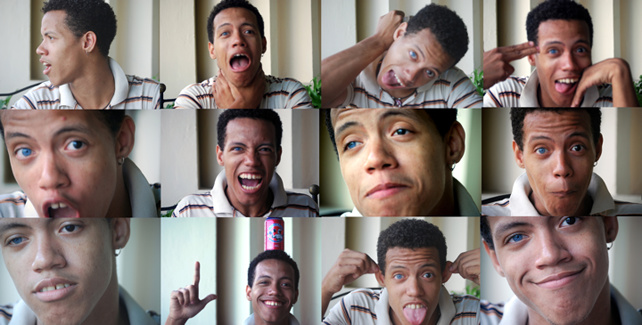 To get back to the show, I thought it was interesting how the walls are lined with small pictures coming together to form bigger pictures, while the centerpiece is a gigantic image hung from the ceiling of a naked man with a big penis in the shower. Personally I found that to be a very calming thing. After looking at all these pictures that make your mind race, you see a very private image of a man in the shower. Was that a conscious effort to make people relax and realize that sometimes we need privacy?
To get back to the show, I thought it was interesting how the walls are lined with small pictures coming together to form bigger pictures, while the centerpiece is a gigantic image hung from the ceiling of a naked man with a big penis in the shower. Personally I found that to be a very calming thing. After looking at all these pictures that make your mind race, you see a very private image of a man in the shower. Was that a conscious effort to make people relax and realize that sometimes we need privacy?
That’s a really interesting take on it. Because it is a very calming image, I think. With the water, and the thin organza that it’s printed on… it adds a light thing to it. And yes, he does have a very large penis, but it’s not like I intended people to focus on the big scary cock. I was actually surprised when a lot of people I know and love said they had never seen a cock that big—they must not have been around as much as I have.I like the idea of having one huge, calming photograph hanging in the middle of a bunch of smaller pictures that are stitched together to make larger, new images.
Well, it’s interesting that you point that out because we almost used a different image there. All of the images, besides that one, that we thought about putting there were about death, because there’s a lot of stuff about death in the show. And the decision to use that image was about not making the show about death, because it does make the biggest statement in the gallery. And, you know, I’d rather get in the shower with a guy with a big cock than go to a cemetery. I guess that’s a pretty simple-minded way of saying it, but it’s sort of the message. Moving on to the videos, in your film Soap, which is inspired by a poem by Francis Ponge, you use soap to get people to talk about everything from marriage to World War II. Did you give them ideas for stories that you might want to talk about, or did it just happen organically?
Moving on to the videos, in your film Soap, which is inspired by a poem by Francis Ponge, you use soap to get people to talk about everything from marriage to World War II. Did you give them ideas for stories that you might want to talk about, or did it just happen organically?
No. In fact, with Stephen Prina and Allan McCollum, I just went to an opening and said, “Would you let me turn my camera on? OK, talk about soap. Tell me something interesting about soap.” And other people… I didn’t really prompt anybody, but I might have told them a little in advance that I wanted them to be in it and that they should tell a story about their relationship to soap, or really just say anything they wanted about soap. Everybody found a way to talk about something that was important in a funny way—well, all weren’t that funny—but they talked about things that were important to them through the medium of this object.What kind of soap do you use?
Well, you know when I was making Soap, I collected so much of every conceivable kind that I actually still have some weird types and every once in a while I’ll use them. But to be honest, the thing I usually use is Dr. Bronner’s liquid soap.I hate that stuff.
I like it because I can just reach up and squeeze it on my hair and soap myself down in a few seconds and be done with it, whereas with a bar of soap I always sort of want to masturbate… really.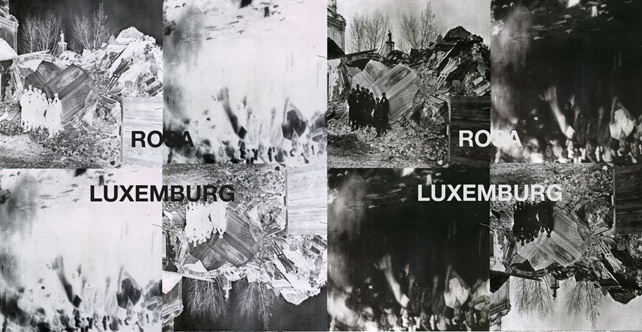 That’s always a bad idea though. If soap gets in the hole it stings horribly.
That’s always a bad idea though. If soap gets in the hole it stings horribly.
I don’t masturbate by sticking things up my ass.I’m talking about the pee hole.
Of the cock? How would it do that?It just seeps in there somehow.
Well if it’s a bar of soap then you’re just lathering your cock—I mean you’re not like rubbing it into the head of your penis. The liquid soap, I mean, it could get up there, but I’ve never had that experience. Moving on.You’ve organized a reading of The 120 Days of Sodom that’s happening on Saturday.
Moving on.You’ve organized a reading of The 120 Days of Sodom that’s happening on Saturday.
Yes. Back in 1989, when a fatwa was declared against Salman Rushdie, all the OK writers went to Lincoln Center and they read banned books. The only books they read from, however, were religious texts: In other words, nothing that had been banned in the 20th fucking century. No books that were banned for political reasons, no books that were banned for sexual content… just religious stuff. And since this was all being read by atheists, I thought it was the apogee of hypocrisy, to avoid what was really controversial. So I organized a counter antifatwa reading at a gallery on Lafayette Street. Everybody read from The 120 Days of Sodom—it was like, we want to support freedom of expression, but we want to support real freedom of expression, something that you guys find very uncomfortable. Saturday’s reading is a reprisal of that event.Gristle Springs will be at Participant Inc., (253 East Houston Street), until May 20. The reading of The 120 Days of Sodom will take place on Saturday at the 3 PM at the gallery.Follow Jonathan on Twitter @Jonathan_Smth
Advertisement

Gary Indiana: The last show I did was at American Fine Arts with Colin de Land, who was a very loved figure, a really smart guy. Then he died, and after Colin died other gallery people approached me, but they would all say things like, “Well, what do you want to do with this work?” and I would say, “I already did it. Do you mean, do I want to achieve world domination? Not particularly.” I mean, basically they were asking for a marketing strategy without coming right out and asking for a marketing strategy. That’s fine, but I wasn’t interested in doing that, because one advantage of not being particularly money-grubbing is that you don’t have to funnel all your energy in one direction. I’m not trying to make myself out as a noble person. I’m just bad at money. I’m bad at telling people why they should buy something I did. Of course, they’re welcome to. Please. But I was never a good hustler that way.
Advertisement
Well, I’ve been working with pictures constantly since the last show. My friends and I had talked about me doing another show for a long time, and it just took several years for it to get to the point where I knew what I wanted to do. Also, I felt that if I was going to break out of this mold—if you’re a writer, particularly in America, that’s all you’re supposed to do—and actually establish in people’s heads that I do this seriously, I should probably do it now. I’m not going to be alive that much longer.

Anybody in Europe can do 40 different things, but here you’re supposed to be a specialist in one thing.I find that American writers more than American artists are really provincial people. They don’t mind being just writers because they live in this very clammy, creepy little world—writers’ conferences and PEN and all that stuff. It is really like going to a funeral to go to any of those events with poets and writers. Every time I go I feel like, Where’s the vodka, where’s the booze? Because this is a funeral.I don’t think you’re alone in that opinion. The photos in the show date back 30 years, right?
Strictly speaking, there are photos in the show that date that far back. Primarily the photos in the show were done in the last two or three years, but I’ve worked with a huge range of cameras since I started taking pictures in the 70s, and different series have been taken here, there, and all over the world, and there were certain things that I loved in all of them. But you can’t show them in a straightforward style—in a series with other photos shot at the same time or place—because they would just fight with each other. So I thought, How can I put these together in a way that will kind of turn the diversity of them into an asset? So that’s when I started making the cruciform things and diptychs and panels of images. The ones that are basically four panels, the images are not supposed to have anything directly to do with each other. I might have a private way of connecting them, but I don’t really tell myself a story. Part of the exercise was trying to arrange these pictures so that people would like seeing them together without necessarily figuring out why they were together.
Advertisement
I do. I think a lot of them could conceivably stand on their own, but I don’t want them to. I think that they do sort of reinforce each other in a very peculiar way. It’s weird, because everything in the show is about not doing anything obvious or eliminating all the reasons to do it this way, except for what can’t be explained. Obviously some pieces have a different idea, like the Rosa Luxemburg piece and the Chinese cemetery piece, for example. I was trying to get at other things in those pictures. When I look at the show, I see where those pictures were taken and what I was thinking about when I took them, but I didn’t want to identify them necessarily in that way.

Well there is a reason, but it’s sort of contrary to what you would think. Those pictures were taken at a Chinese cemetery in Havana. Some are done in a way that you can tell the family has money, and some just have a name scrawled across them in pencil. And they do have numbers. I’m not actually sure what those numbers are supposed to correspond to, though. They’re not in order on the wall, but I figure they put them in some sort of weird Fibonacci order. Anyway, I repeated 45 because I didn’t want people to think that there was a system involved in that.
Advertisement
Well I don’t want people to be like, “Oh, this is why this is the way it is.” So I just repeated that number, so people can see that this is a construction. The number doesn’t have any meaning to me, and the picture doesn’t have any more meaning than the rest of them.

Yes and no. I think maybe people are evolving skills to cope with technology that people in the past didn’t have. I regularly go from here, which is the media capital of the country, to LA, to a place [Cuba] where I have no internet and no television. It’s really pulling the plug out, in a way you couldn’t even do in a place like Iceland or Dhakar, because all those places have WiFi. It’s possible to live over there for a long time without any of that. And I do. So I guess when I come back I just have some distance from what it’s like being supersaturated with the media. But I’m a junkie like everyone else. I can very easily spend hours on the internet, or watching television. Which is why I leave so often, because I don’t want to fall into that sinkhole, because you do lose your powers of concentration.
Advertisement
I don’t really care what happens to children when they grow up. I’ll be dead. I can’t worry about it, because I think probably the future’s going to be really bad. But maybe being ignorant of so many things that are going to disappear anyway will be a survival tool. I like children, by the way. I’m not saying I don’t care about what happens to them because I don’t like children, I’m saying I don’t care what happens to them because I’m not going to be around to see it.

That’s a really interesting take on it. Because it is a very calming image, I think. With the water, and the thin organza that it’s printed on… it adds a light thing to it. And yes, he does have a very large penis, but it’s not like I intended people to focus on the big scary cock. I was actually surprised when a lot of people I know and love said they had never seen a cock that big—they must not have been around as much as I have.
Advertisement
Well, it’s interesting that you point that out because we almost used a different image there. All of the images, besides that one, that we thought about putting there were about death, because there’s a lot of stuff about death in the show. And the decision to use that image was about not making the show about death, because it does make the biggest statement in the gallery. And, you know, I’d rather get in the shower with a guy with a big cock than go to a cemetery. I guess that’s a pretty simple-minded way of saying it, but it’s sort of the message.

No. In fact, with Stephen Prina and Allan McCollum, I just went to an opening and said, “Would you let me turn my camera on? OK, talk about soap. Tell me something interesting about soap.” And other people… I didn’t really prompt anybody, but I might have told them a little in advance that I wanted them to be in it and that they should tell a story about their relationship to soap, or really just say anything they wanted about soap. Everybody found a way to talk about something that was important in a funny way—well, all weren’t that funny—but they talked about things that were important to them through the medium of this object.
Advertisement
Well, you know when I was making Soap, I collected so much of every conceivable kind that I actually still have some weird types and every once in a while I’ll use them. But to be honest, the thing I usually use is Dr. Bronner’s liquid soap.I hate that stuff.
I like it because I can just reach up and squeeze it on my hair and soap myself down in a few seconds and be done with it, whereas with a bar of soap I always sort of want to masturbate… really.

I don’t masturbate by sticking things up my ass.I’m talking about the pee hole.
Of the cock? How would it do that?It just seeps in there somehow.
Well if it’s a bar of soap then you’re just lathering your cock—I mean you’re not like rubbing it into the head of your penis. The liquid soap, I mean, it could get up there, but I’ve never had that experience.

Yes. Back in 1989, when a fatwa was declared against Salman Rushdie, all the OK writers went to Lincoln Center and they read banned books. The only books they read from, however, were religious texts: In other words, nothing that had been banned in the 20th fucking century. No books that were banned for political reasons, no books that were banned for sexual content… just religious stuff. And since this was all being read by atheists, I thought it was the apogee of hypocrisy, to avoid what was really controversial. So I organized a counter antifatwa reading at a gallery on Lafayette Street. Everybody read from The 120 Days of Sodom—it was like, we want to support freedom of expression, but we want to support real freedom of expression, something that you guys find very uncomfortable. Saturday’s reading is a reprisal of that event.Gristle Springs will be at Participant Inc., (253 East Houston Street), until May 20. The reading of The 120 Days of Sodom will take place on Saturday at the 3 PM at the gallery.Follow Jonathan on Twitter @Jonathan_Smth
